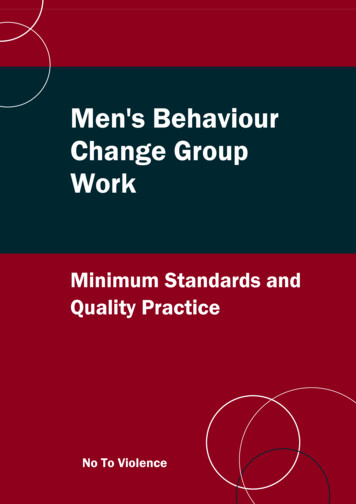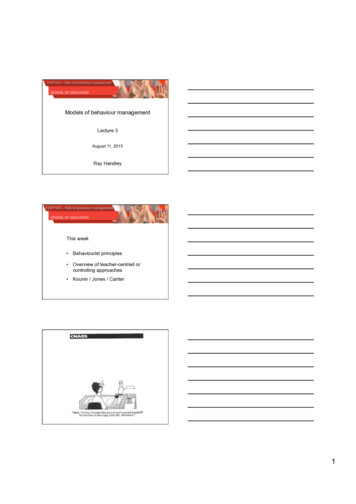
Transcription
Men's BehaviourChange GroupWorkMinimum Standards andQuality PracticeNo To Violence
Table of ContentsACKNOWLEDGEMENTS4ABOUT NO TO VIOLENCE6ABOUT MEN’S REFERRAL SERVICE8INTRODUCTION TO THE MANUAL10BackgroundHow to use this ManualTerminology101113INTRODUCTION TO THE MINIMUM STANDARDS15The case for Minimum StandardsThe case for Good Practice GuidelinesHow the Manual and Minimum Standards were developedResponsibility for implementing the Minimum StandardsComplying with the Minimum Standards1516161718UNDERSTANDING MALE FAMILY VIOLENCE19Male family violence: a definitionKey elements of male family violenceNTV's understanding of male family violenceCommon misconceptions about male family violenceForms of male family violence1920212325EFFECTS OF MALE FAMILY VIOLENCE27The effects of male family violence on womenThe effects of male family violence on childrenThe effects of male family violence on women's parentingParenting by men who use family violence27293132RESPONDING TO MALE FAMILY VIOLENCE33Putting men's behaviour change work in contextWorking with men for changeA rationale for men's behaviour change group workExperiences of men's behaviour change programs33353740— 1—
STAFFING MEN'S BEHAVIOUR CHANGE PROGRAMS43Tasks associated with men's behaviour change programsWork roles in men's behaviour change programsStaff skills, experience and qualificationsGender of contact workersProfessional development requirementsNumber and gender of facilitatorsFormal roles for previous participants43444650515254PROGRAM PLANNING56Theoretical positioningPartnerships and networkingProgram structures and durationCore messages and skills56575963ACCESS AND PARTICIPATION66Marketing men's behaviour change programsEligibilityHandling enquiriesIntake assessmentReferral for men who are ineligible or choose not to participateInduction to the groupWaiting list managementClient rights and responsibilitiesGroup agreementsInclusiveness (1): Accountability to Indigenous peopleInclusiveness (2): Working in a context of cultural and linguistic diversityInclusiveness (3): Challenging Record keeping and filesConfidentialityReporting to courts and other statutory or non-statutory bodiesFollow-up after a man's exit from a program949799101ACCOUNTABILITY TO FAMILY MEMBERS103Thinking about accountabilityHearing women's and children's voices in the processWhat may be communicatedFrequency of contactDuration of contactForm of contactWho should be contacted103104107109110111112— 2—
SAFETY114Practices that help to keep people safeEvaluating and responding to threats to safetyResponding to illegal acts of violent and controlling behaviourResponding to breaches of court ordersChild protectionStaff wellbeing and safety114116118122124126PRACTICE AND PROGRAM DELIVERY128Activities in group workAddressing collusion, condoning of violence and misogynyReflective 136137MONITORING AND EVALUATION138Issues in monitoring and evaluationLanguage of evaluationUse of control groupsResearch by people other than program staff138143143144SELF-REGULATORY FRAMEWORK FOR NTV'S MINIMUM STANDARDS145Overview of the self-regulatory frameworkRationale for a self-regulatory frameworkPrinciples for a self-regulatory frameworkNTV's process for monitoring compliance.Responding to a complaint about non-complianceSteps in the review processA process for providers to review and improve their existing policies, procedures andpracticeA process for NTV to review and improve its self-regulatory framework145146147148149150152152SUMMARY OF MINIMUM STANDARDS153SUMMARY OF GOOD PRACTICE GUIDELINES163END NOTES169— 3—
AcknowledgementsThis Manual was produced by No To Violence (NTV), funded by the VictorianDepartment of Human Services.It was written and designed by Elizabeth Wheeler, with the support of Advisory Groupmembers:Alice BaileyDomestic Violence and Incest Resource Centre (DVIRC)Danny BlayNo To ViolenceJanine BushDomestic Violence Victoria (to February 2004)Tracy CastelinoLifeworks (joined May 2005)Andrew ComptonMen’s behaviour change practitionerSusan CostelloSchool of Social Science & Planning, RMITBree OliverDomestic Violence VictoriaCoral SpencerDepartment of Human ServicesKaye SwantonLifeworks (to May 2005)Gael WallaceMonash Link CHS (to December 2004)Ivan WilsonOngoing Change Group (to March 2005)Michele WrightInner South Community Health ServiceNTV thanks all of the individuals and organisations who shared their stories, ideas,dilemmas, research, and comments on the drafts. This document is much richer fortheir input and NTV appreciates the time and energy they contributed to the process.In particular, NTV wishes to appreciate the groundbreaking work of Barbara Youngerin developing the first volume of the NTV Standards of Practice in 1995. The verynotion that there could be Standards of Practice is testament to her skill, energy, andcommitment to quality and accountability in men’s behaviour change programs. TheV-NET Committee that assisted Ms Younger in her work must also be congratulatedon its vision and hard work.NTV also recognises the contributions of Pete French in reviewing some aspects ofthe NTV Standards of Practice in 2000.Of course, NTV's work around the Standards of Practice has benefited from the workof countless others – as practitioners of men’s behaviour change, as staff of women'sservices, as volunteers with NTV or Men's Referral Service, as policy makers, asresearchers, and as activists. NTV honours and thanks all of these individuals andorganisations for their contributions to prevention of male family violence.— 4—
This page is intentionally blank— 5—
About No To ViolenceNo To Violence (NTV), the Male Family Violence Prevention Association, is theVictorian state-wide peak body of organisations and individuals working with men toend their violence and abuse against family members. NTV members come from awide range of professional and community backgrounds and work in a range ofsettings including government, community-based settings and private practice.NTV aims to:¡Work towards the reduction and prevention of male family violence and fosternon-violent relationships through working with individuals, families and groups.¡Be aware of, and work towards ensuring the safety of partners and children,workers and participants at all times.¡Challenge and work towards changing the patriarchal systems which condoneviolence or provide a context in which violence can occur.¡Focus on programs for men taking responsibility for stopping their own violence,as part of a broad-based, co-ordinated and integrated response to male familyviolence, which includes women's, family and adolescent services, andcommunity and school education.¡Develop and regularly review NTV policies and practices to enable effective workin the area of male family violence.¡Facilitate networking, support and information-sharing between workers runningprograms for men who are violent in the family.¡Encourage and develop practices which are grounded in an awareness of powerand control in gender relations.¡Provide a model of equality between female and male members of NTV.¡Develop and recommend standards of practice for work with men who are violentin the family.¡Liaise about standards of practice and skill development with other relevantbodies on behalf of NTV members.¡Facilitate skill development for individuals and program providers likely to beworking with men who are violent in the family.¡Encourage participation by NTV members in public discussion and communityeducation to raise awareness about male family violence.¡Promote the provision of adequate levels of services for women and men toaddress male family violence.¡Promote the development of men who have participated in programs to stopmen's violence to be advocates for the elimination of violence, and the promotionof justice for women and gender equality in the community at large.¡Facilitate the development of resources for use by the field.— 6—
This page is intentionally blank— 7—
About Men’s Referral ServiceThe Men's Referral Service (MRS) is the Victorian gateway provider for men who aremaking moves towards taking responsibility for their violent or abusive behaviourtoward their family. MRS has been operating since 1993 and is a valued and highlyregarded Victorian family violence service funded by the Victorian Department ofHuman Services. MRS is a service of NTV and a key part of the men’s behaviourchange program framework in Victoria.As the central point of contact, MRS provides anonymous and confidential telephonecounselling, information and referrals to men to assist them to take further action tostop their violent and abusive behaviour. The safety of the caller, their partner andfamily, is always checked by the service.MRS also acts as an important interim and after-hours counselling option for men’sbehaviour change programs. Participants in programs or those on waiting lists areencouraged to contact MRS in between group sessions, and in times of recess,holiday or in the period after a program finishes or closes. The telephone counsellingprovided by MRS can provide important crisis counselling, intervention, angermanagement education and safety assessment for participants during these times.MRS also helps professionals and workers in many fields find the most appropriateservices for male clients who have been using violence toward their partner or familymembers.MRS has an extensive and detailed referral database and is a primary informationsource for male family violence related services in Victoria. The database providesthe most accurate, up-to-date and appropriate referral information to callers.MRS only refers to men’s behaviour change programs that are provided by NTVmembers.— 8—
This page is intentionally blank— 9—
Introduction to the ManualBackgroundBehaviour change work with men is similar in some ways to other types of counsellingwork, but very different in other ways. It carries extra risks to all involved and requiresspecific skills and knowledge related to family violence and working with men whouse violence.In 1994, NTV (then V-NET) published 'Stopping Men's Violence In The Family: AManual for Running Men's Groups, Volume 1, Context and Standards'. The Manual,containing Minimum Standards, best practice goals and discussion of some of thecentral issues surrounding men's behaviour change work, was one of the first of itskind in the world. It arose from concern about the potential dangers to women andchildren in working inappropriately with men who use violence. Given the specialisedand difficult nature of the work, the intent of the Manual was to promote and enableresponsible men's behaviour change work.Since its publication, the Manual has been used widely by men's behaviour changeprogram providers, facilitators, researchers, students and activists against familyviolence. It has been a source of information and ideas, a guide to establishing newprograms and a basis for ethical decision-making.It was always NTV's intention to review the Manual. In the ten years since the Manualwas published, much has changed. Collectively, men's behaviour change programproviders have more experience. Understandings have deepened and praxis haschanged.This Manual is the product of a comprehensive review process over nine months.Whilst it is based on the sentiments of the original Manual, it has a new structure,considerable new content and some deletions. The Minimum Standards have beenrefined and added to, and a set of Good Practice Guidelines has been developed.This continues to be a work-in-progress. No doubt, as the field of men's behaviourchange continues to develop, there will be new thinking, new approaches and newways of doing things. NTV looks forward to nurturing these developments, andsupporting debate and discussion with all those who share an interest in preventingmen's violence and promoting the safety of women and children.Finally, no one resource can address all the subtleties and complexities of malefamily violence and men's behaviour change work. NTV recommends that this Manualbe read alongside the many books and journals dedicated to strengthening thesafety, integrity and relevance of men's behaviour change work.— 10 —
How to use this ManualThis Manual is intended to provide guidance and support for new and existingproviders of men's behaviour change programs. It also provides the MinimumStandards and Good Practice Guidelines for practising men's behaviour change work.It is not intended as a guide to curriculum, or a complete toolkit for conductinggroups.Introduction to the Manual provides readers with the background to NTV and MRS. Italso defines some of the terminology used in the Manual.Introduction to the Minimum Standards outlines the case for Minimum Standards,who is responsible for implementing them, and a brief overview of the processinvolved in developing them.Understanding male family violence defines what is meant by the term male familyviolence. It summarises NTV's understandings of male family violence and looks atsome common beliefs about it.Effects of male family violence looks at how men's use of violent and controllingbehaviours impacts on women, children and parenting.Responding to male family violence places men's behaviour change in the context ofbroader community responses to male family violence and talks about working withmen for change. It provides a basic rationale for men's behaviour change group workand talks about some common experiences that women and men have of men'sbehaviour change programs.Provider requirements looks at the capacities and resources that providers need ifthey are to provide men's behaviour change programs that do not have the effect offurther jeopardising the safety of women and children.Staffing men's behaviour change programs provides an overview of the staffingconsiderations of men’s behaviour change programs, including staff roles andqualifications, the number and gender of staff required, and the involvement of menas peers or mentors.Program planning considers some of planning components of program delivery,including how providers position themselves theoretically, the importance ofpartnerships and networking, ways that men’s behaviour change programs may bestructured, and the core messages and skills that providers must communicate ingroup work.Access and participation talks about ways to market men's behaviour change,eligibility requirements, intake and assessment processes, contracts for men, andgroup rights and responsibilities. It also discusses ways that men’s behaviour changeprograms should be inclusive, with information, ideas and Minimum Standards aboutaccountability to Indigenous people, working in a context of cultural and linguisticdiversity and challenging homophobia.Administration provides guidelines and suggestions about a range of mattersincluding record keeping, confidentiality and reporting. It also discusses processes forwhen a man leaves a program.— 11 —
Accountability to family members looks at some of the practices for accountability towomen and children, individually and collectively. It includes ideas for bringingwomen's and children's voices into the men's behaviour change process.Safety provides information and suggestions on practices that help to keep peoplesafe, assessing and responding to threats to safety, responding to illegal acts ofviolent and controlling behaviours, responding to breaches of court orders, and onstaff wellbeing and safety.Practice and program delivery discusses the need to prevent the collusion andcondoning of violence and misogyny. It offers suggestions and Minimum Standardson reflective practice, observation, debriefing and supervision.Monitoring and evaluation looks at some of the dilemmas of measuring andevaluating men's behaviour change work, and includes Minimum Standardsregarding evaluation of program delivery and assessment of individual men.— 12 —
TerminologyFamilyThe nature of the relationship between the parties is an important differencebetween male family violence and other forms of violence. Generally male familyviolence involves behaviour towards other members of one's family. Family includesmarriage or blood ties, de facto relationships or relationships of a similar nature tothese, such as stepparent to stepchildren. The setting is also relevant. Generally, theparties are or have been living together, but this is not always the case. The relevantrelationships are characterised by emotional and other intimacy, a high degree oftrust and the voluntary dropping of some of the boundaries normally kept with otherpeople. This results in increased vulnerability to the behaviour of the other familymembers.ViolenceMen's behaviour change programs frequently address behaviours that do not involvephysical violence, but that affect others' health, wellbeing, freedom, sense of safetyand autonomy. Some people might not think of these when they see the word'violent', or might hesitate to call them violent. For this reason, NTV generally uses theterm 'violent and controlling behaviours' to cover the wide range of behaviours thatviolate the right of another person to safety, autonomy and wellbeing.Male family violenceAs an organisation, NTV's focus is on the violent and controlling behaviours that somemen choose to use towards women and children with whom they have intimateand/or family-like relationships. NTV recognises that gendered power relations, alongwith many other factors, are implicated in these behaviours. For this reason, NTV haschosen to use the term 'male family violence' in this Manual.Gender-specific languageAt present, the vast majority of men who participate in men's behaviour changeprograms do so in the context of their heterosexual relationships. NTV believes thatgender is an important – though not single – factor in male family violence. Inconsultation with providers of gay men's behaviour change groups, NTV has decidedto give primacy to the intent to talk about people in their own right, not in relationshipto another. For this same reason, in this Manual NTV chose to use language that isgendered female and to avoid the term 'partner', which for some, places men at thecentre by defining women primarily through their relationship to a man.NTV recognises that men who use violence are not always heterosexual and believesthat much of the content of the Manual is highly relevant to men's behaviour changeprograms for men in same-sex relationships. NTV strongly encourages the uptake ofthe Minimum Standards and Good Practice Guidelines in these settings.Women who have experienced violence— 13 —
The question of how to refer to people who have had violence used against them hasbeen hotly contested for decades. Some believe that the term 'victim' reinforcespeople's sense of powerlessness. Yet we must recognise that not all women feelthemselves to be survivors, and that not all women do survive male family violence.Furthermore, the terms 'victim' and 'survivor' are sometimes seen to construct a typeof person rather than a type of experience. They might not allow for all the otheraspects of a person's life, identity and experience; instead, they define her byreference to someone else's actions towards her.For these reasons, in this Manual, NTV chose to refer to 'women who haveexperienced violence'. Sometimes this is abridged to 'women'.ChildrenMale family violence affects babies, preschoolers, pre-adolescent school-agedchildren and adolescents. Historically, this has been ignored, and often babies,children and young people are rendered invisible in discussions of male familyviolence. In this Manual, NTV chose to draw attention to the importance of thinkingabout and responding to the needs of babies, children and young people. In theinterests of readability, NTV chose to use the word 'children' to refer to all peopleunder the age of eighteen years.Men who use violencePeople often use the word 'perpetrator' to refer to men who use violence. This term isnot used in this Manual because it suggests a type of person rather than a type ofbehaviour. Men who use violence choose to do so, and can choose not to. In thisManual, the term 'men who use violence' is used instead. In some cases, the term isabridged to 'men'.— 14 —
Introduction to the MinimumStandardsThe case for Minimum StandardsMen's behaviour change programs are provided by many different providers and inmany different settings. They are facilitated by people of diverse backgrounds,disciplines and theoretical posititionings. There are great disparities in the resourcesavailable for men's behaviour change work. These differences mean that each men'sbehaviour change program will be unique.Whilst respecting and valuing uniqueness, NTV believes there are some MinimumStandards for men's behaviour change work. These are necessary for:Safety. The aim of behaviour change work with men is to promote women's andchildren's safety. Where this work is conducted inappropriately or without adequatesafeguards, interventions with men have the potential to endanger women andchildren, staff and others. Minimum standards of practice establish a basicframework for working with men in a manner most conducive to the safety of allinvolved.Accountability. Men's behaviour change work is undertaken in the interests of safetyfor women and children. Without opening men’s behaviour change work to theirscrutiny and feedback, NTV and program providers risk further reinforcing patriarchalsocial relations in which women's and children's voices and experiences aredisregarded. Structures and processes for accountability to women and childreninclude:¡Contact with individual women and children.¡Links and partnerships with women's and children's services.¡Relationships with government.Quality assurance. Men's behaviour change programs are a service, and as suchneed benchmarks for quality and processes for complaints or grievances.Public information. People seeking to join or refer men to behaviour change programsare often not in a position to assess the suitability or safety of programs. Minimumstandards of practice enable referrers to be confident about the appropriateness,quality and integrity of a service.Facilitating the safe expansion of programs. Men in many parts of Victoria have noaccess to men's behaviour change programs. NTV is committed to assisting thedevelopment of new programs by making clear the minimum requirements for theirestablishment, conduct and evaluation.NTV chose to continue to use the phrase 'Minimum Standards' as this phrase mostaccurately reflects the fact that there are policies, procedures and practices that areimperative for safe, ethical men's behaviour change work. These are the minimumnecessary to ensure that men's participation in men's behaviour change programsdoes not increase the danger to women and children.— 15 —
The case for Good Practice GuidelinesOf course, this Manual also advocates policies, procedures and practices that exceedminimum requirements. Some are identified as Good Practice Guidelines (designatedin the text as GPG #).These guidelines do not meet NTV's criteria for Minimum Standards, however most, ifnot all, are essential for quality practice. It is hoped that all members will aspire toreach and then surpass the Good Practice Guidelines as they expand and enrich theirprograms over the years.How the Manual and Minimum Standards weredevelopedThis document was prepared by the Project Officer and Advisory Group on behalf ofNTV. It draws on many different sources, including:¡The original NTV Manual and Standards.¡The stories, questions, practice dilemmas and reflections of men's behaviourchange program providers and women's services.¡Literature summarising qualitative and quantitative research.¡The Continuum Matrix of Practice, published by Partnerships Against DomesticViolence.¡Taking Responsibility, the Victorian Government's framework for developing bestpractice in programs for men who use violence toward family members.¡National competencies outlined by Partnerships Against Domestic Violence.Milestones in the development of the Manual were:¡Literature review¡Consultations with providers and other stakeholders¡Survey of existing men's behaviour change groups¡Proposal for structure, content and Minimum Standards disseminated toproviders and other stakeholders¡Consultative forum¡Dissemination of a full draft of the Manual for feedback¡Second draft of the Manual¡Consideration of recommendations by the NTV Management Committee¡Adoption of the Manual by the NTV Management Committee.— 16 —
Responsibility for implementing the MinimumStandardsThe Minimum Standards and Good Practice Guidelines in this Manual are intendedfor all entities that provide men’s behaviour change programs or groups, regardlessof whether they are agencies, organisations, businesses or sole traders.NTV regards this issue of responsibility as critical. Firstly, fulfilling NTV's MinimumStandards and providing quality men's behaviour change programs requires acomprehensive approach. Secondly, men's behaviour change programs are usuallyconducted in the name of an entity, and thus, the reputation and good standing ofthat entity is at stake in its delivery of quality men’s behaviour change programs.Thirdly, many aspects of men's behaviour change work are policy or procedural innature, and are beyond the influence of individual members of staff.Entities that provide men's behaviour change programs must have organisationalmembership of NTV to be recognised as men’s behaviour change program providers.Their governance bodies bear ultimate responsibility for upholding the MinimumStandards and for the conduct and quality of all program activities. All relevant seniormanagers should be aware of the Minimum Standards and their organisation'sresponsibility for upholding them.MS 1Responsibility for implementation of NTV'sMinimum Standards rests with the governancebody of the lead provider.— 17 —
Complying with the Minimum StandardsProviders wishing to establish and maintain men's behaviour change programs thatcomply with the Minimum Standards should ensure that they:¡Have a thorough understanding of the dimensions, effects and nature of malefamily violence.¡Have agreed theoretical approaches and responses to male family violence.¡Have adequate resources to meet all of the Minimum Standards.¡Have positive relationships with local family violence and women's and children'sservices, services for populations with particular needs (including Indigenous andCulturally and Linguistically Diverse services), police and court staff.¡Can provide information, support and accountability to women and childrenaffected by participants' use of violence (this might be through inter-provideragreements).NTV does not believe that all services within a men's behaviour change program mustbe provided within the one provider, however, it is clear that providers wishing toprovide such programs have a responsibility to ensure that services can be providedin a holistic, appropriate and timely fashion. Involving various providers increases thecomplexity of case management and increases the likelihood that clients will ceaseusing services. Furthermore, there is some evidence that drop-out rates are lowerand case management is improved when the woman and the man can remain underthe one provider's auspice.1 Inter-provider service provision necessitates carefulplanning to ensure a seamless delivery of services.— 18 —
Understanding Male FamilyViolenceMale family violence: a definitionMale family violence occurs in the context of intimate relationships.It is 'a pattern of coercive control that one person exercises over another in order todominate and get his way. It is behaviour that physically harms, arouses fear,prevents a person from doing what she wants, or compels her to behave in ways shedoes not freely choose.'2Family violence can occur in many different kinds of intimate relationships. Forexample, from one partner towards another, between partners, from a parent to achild, from an adult to an elderly relative, from an adolescent towards a parent. Mostfrequently however, family violence is perpetrated by men against women andchildren. Male family violence is an expression of gendered power; that is, the powerthat men – individually and collectively – have over women and children.— 19 —
Key elements of male family violenceMale family violence is violation.Male family violence is any form of behaviour by men, in the context of intimaterelationships, which violates the right of another person to autonomy, dignity, equalityand respect.Male family violence is power over.Male family violence is behaviour that expresses men's power over another.Male family violence perpetuates and reinforces male power over women andchildren.Men's needs and wants are given primacy over others – at individual, social andsystemic levels. Male family violence perpetuates and reinforces this primacy.Unintended violence is still violence.Intention is not necessarily a defining feature of male family violence. Any behaviourthat causes violation is violent or controlling, regardless of whether the man isconscious of any intention to exert power or control. Behaviour is still violent orcontrolling even if a man says he feels powerless himself, or is not aware that thebehaviour is violent or controlling.Male family violence causes fear.Those who experience male family violence become fearful of potentially violentsituations and/or of the person who uses violence. They frequently modify their ownbehaviour to try to prevent or cope with the violence. Experiencing male familyviolence makes it increasingly difficult for women and children to be themselves, andto speak and act freely in their own interests.
In 1994, NTV (then V-NET) published 'Stopping Men's Violence In The Family: A Manual for Running Men's Groups, Volume 1, Context and Standards'. The Manual, containing Minimum Standards, best practice goals and discussion of some of the central issues surrounding men's behaviour ch










